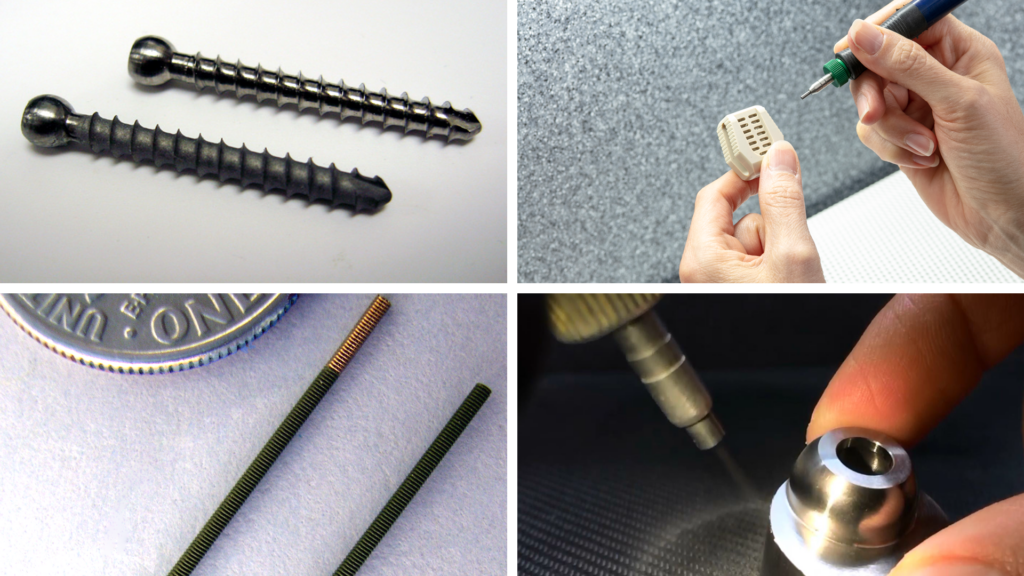Industry Partnerships
Second Applications for your MicroBlaster
Many of our customers buy a MicroBlaster for a single application and find it to be indispensable. However, a common fear for job-shops and contract manufacturers is that the contract they bought a new piece of equipment for will only be used for one job.
Investing in any equipment is a considerable cost. Your mind can’t help but wander to the untouched appliances in the back of your kitchen. The breadmaker you bought a month before going keto. A crepe pan you used exactly once. The juicer you bought while committing to getting fit. There are some single-use machines, like your toaster or coffeemaker, that are indispensable. Others…not so much.
Our systems are more like a microwave than a panini press – even if your neighbor only uses it to heat frozen meals every night, you might find it indispensable for making hot chocolate or steaming vegetables. Like your microwave, you can use your MicroBlasting system for more than one application. Overall, about one-third of our clients (including most of our machine shops) have used their MicroBlasting systems for multiple applications.

From Polymers to Metals
One of our customers found us after receiving an order for PEEK implants, a material we’ve covered extensively before. Through testing, we were able to demonstrate MicroBlasting as a superior technology to scraping off burrs individually with small picks, so the company purchased an AccuFlo® and ProCenter Plus™ for the application.


Shortly after, that same company received another order for parts that needed deburring – this time, titanium bone screws. Unlike PEEK, deburring titanium with picks is impractical. The only viable alternative to precision blasting is using chemical deburring, a procedure involving corrosive substances with complicated disposal procedures. Thankfully, MicroBlasting can deburr virtually any material, so they didn’t need to buy new equipment. Setting up the deburring process for their second application was as easy as switching out their abrasive and eliminates the need for complicated cleanup procedures.
Coating Removal
Similarly, another customer who initially used MicroBlasting to deburr PEEK received an order for guidewires with a thin layer of PTFE that needed to be removed in small, evenly spaced sections. They were happy to learn that they could easily add a Ring Nozzle to their AccuFlo and ProCenter Plus.
What’s a Ring Nozzle? It’s a nozzle array designed to uniformly blast the outside circumference of wire or tube. Taking the nozzle array on and off is easy enough to switch between applications on a single system.
A Ring Nozzle easily strips PTFE coating from wire.
From Deburring to Texturing
As mentioned above, deburring metals like titanium, aluminum, and stainless steel with MicroBlasting is much safer and simpler than using chemical baths. Machine shops frequently purchase our machines exclusively for that reason. However, many customers who discover MicroBlasting through research for deburring methods are excited to find out that they’ve discovered an improved texturing procedure as well.
A MicroBlasting system is just about the only tool in a machine shop’s arsenal that can both deburr and texture metal parts. It can be used to remove machining marks and create an even surface finish on a wide variety of materials. The aforementioned bone screws are a fantastic example of why using the same tool for deburring and texturing works so well. Some bone screws require texturing on the screw head to increase the surface area (a higher Sdr means improved mechanical bond with a swivel or another fixation device). MicroBlasting provides the precision to texture this portion of the screw selectively.
Applications Lab
Let our experts help find the right solution for your part. We know no two applications are the same. Our Technical Specialists manage sample-part testing and processing from start-to-finish. They actively collaborate with our Sales and Engineering Teams while remaining completely accessible to you throughout the process.





